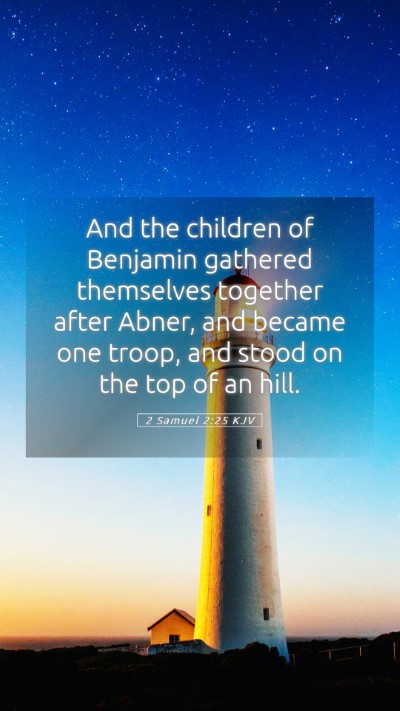Bible Verse Explanation: 2 Samuel 2:25
The verse 2 Samuel 2:25 reads as follows: "And the children of Benjamin gathered themselves together after Abner, and became one troop, and stood on the top of an hill."
Understanding the Context
This scripture is part of the narrative that describes the unraveling of relationships and power dynamics following the death of King Saul. Abner, the cousin of Saul, had taken leadership of the people of Benjamin.
Following Saul's demise, the tribe of Benjamin rallied under Abner. This verse highlights their unity and readiness to support Abner. For a better understanding, it is essential to explore several key themes that arise from this passage:
Key Themes
-
The Unity of a Tribe:
Matthew Henry emphasizes that the gathering of the Benjamites signifies their loyalty to their own tribe and leader, Abner. The organizational structure of tribes during this time often resulted in fierce loyalty, which is a testament to the cultural and social values of the ancient Israelites.
-
The Leadership of Abner:
Albert Barnes notes that Abner's position as a commander in Saul's army now transitions him into a prime leader for the Benjamites. His ability to gather the tribes indicates his influence and the respect he commanded among his people.
-
The Implications of Conflict:
Adam Clarke mentions that the gathering of Benjamites foreshadows the impending conflict between the forces loyal to Saul’s lineage and those supporting David. Unity often leads to heightened tensions, and this illustrates the complexity of the political landscape of that time.
Bible Verse Interpretations
To interpret 2 Samuel 2:25, we can draw from various biblical and cultural lenses. The gathering of the Benjamites encapsulates loyalty that often clashes with destiny as God’s plan unfolds through David. Different commentaries can shed light on unique perspectives and practical applications of this text.
Practical Applications
-
Standing Together:
The concept of unity is crucial in both scripture and modern faith communities. This passage can inspire faith-based discussions in Bible study groups about the importance of standing united in the face of adversity and conflict.
-
Leadership and Responsibility:
The responsibility of leaders is highlighted through Abner’s actions. It can lead to reflections on how leaders influence their communities, urging individuals in online Bible study to consider their roles and the impact of their decisions on collective faith.
-
Historical Context:
Understanding ancient Israel's tribal dynamics can enrich Bible study insights, enabling scholars and groups to grasp how leadership, loyalty, and conflict played vital roles in biblical narratives.
Commentary Insights
The commentaries provide depth to the understanding of this verse. As observed:
-
Matthew Henry:
He illustrates the tension between the kingdoms of Saul and David, adding layers to the implications of such gatherings, which are often pivotal moments in scriptural history.
-
Albert Barnes:
He provides a narrative commentary about the outcome of this division and what it meant for the future of Israel. His analyses add context through a historical and theological lens.
-
Adam Clarke:
Clarke emphasizes the significance of tribal allegiances and transitions, drawing conclusions about the importance of leadership transitions from one dominant house (that of Saul) to another (that of David).
Cross References
This verse resonates with several other scriptures that enrich its understanding:
- 1 Samuel 10:20-21: Saul being chosen as king by drawing lots.
- 2 Samuel 3:12: Abner's negotiations with David.
- 2 Samuel 5:1-3: The anointing of David as king over all Israel.
Conclusion
Understanding 2 Samuel 2:25 through these lenses opens up discussions on loyalty, leadership, and the implications of unity versus conflict. These insights contribute to deeper Bible verse meanings and further enrich Bible study resources, promoting enhanced understanding of scripture among individuals and groups alike.


